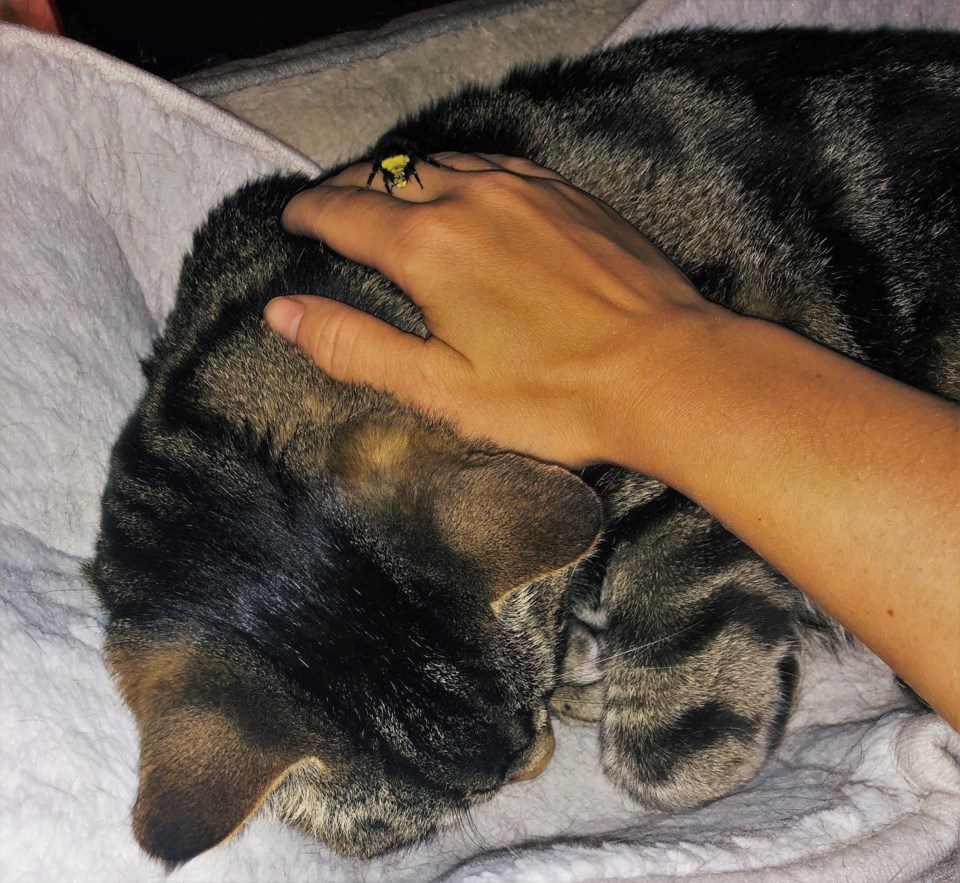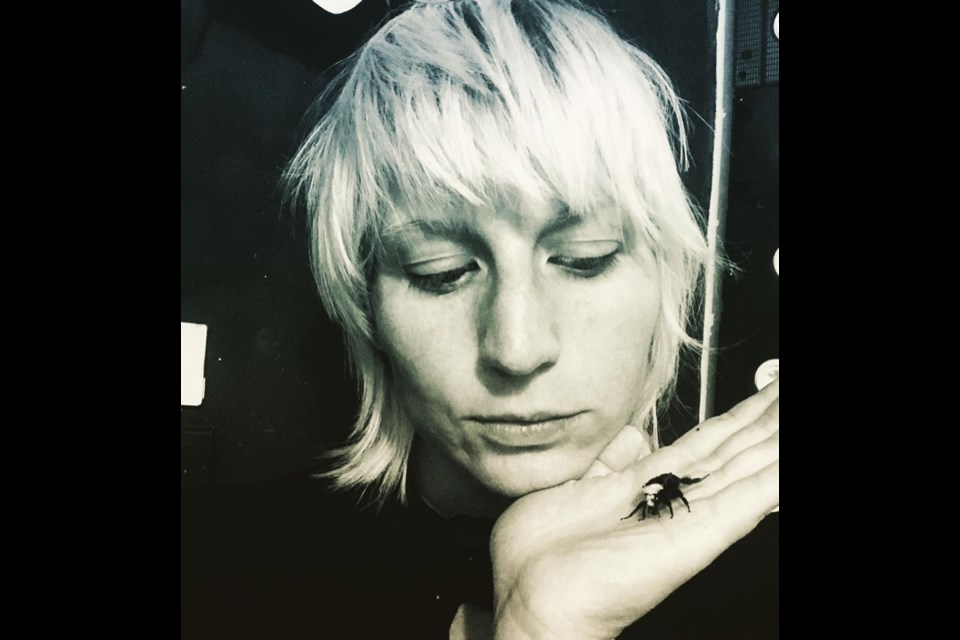It's almost a year to the day since Shay Hayashi was walking down Ruby Street. It was a Tuesday.
She was with her partner, Michael, picking something up. While looking for an address they got turned around; Michael noticed a bumblebee they'd passed on the ground earlier was still on the sidewalk and stopped Hayashi from stepping on it. Hayashi got on the bee's level and noticed it didn't have full-size wings.
"It was just a thing that happened that day, not foreseen in any way," she says. "She was on the sidewalk and then still there 15 minutes later, so I bent down and picked her up."
The bee immediately crawled into her hand.
"I don't want to project, but maybe she was looking for help," Hayashi says.
The two collected a few flowers, as bee food, and headed home. For the next 32 days Ruby Tuesday the bumblebee lived with the couple in Vancouver.
At first they hoped the bee's wings would grow back. They were there, but look like they had shriveled up for some reason, maybe disease or heat, Hayashi isn't sure. Over time the bee became more and more part of the family, even getting along with Pyro the cat.
"To be around her was comforting; she wanted to hang out," Hayashi says. "She was just a really sweet creature. She just accepted and emitted care.
"It was like having a baby unicorn in my palm."
It worked out that Hayashi had her wisdom teeth taken out the day after Ruby was found; for the next two weeks she was able to care for the big bee full time.
"It was like having a little human for a little bit," she describes the experience. "Her emotional and intellectual capacity, I know this sounds weird, but she was so smart."
Ruby would go out in public as well, riding on Hayashi's shoulder for example.
"A lot of people would stop me and say 'You've got a giant bee on you,'" she says.
When she had to go back to work as a nanny, Ruby tagged along.
"The boy I was nannying was a really great kid, he interacted with her, too," she says. "I took them to parks and community gardens."
Even with the young boy, Ruby was calm.
"She was docile enough that she could sit on a two-year-old's arm and hang out with us," she says.
They were together 24 hours a day; when they were at home Michael would hang out and help with the bee as well. Ruby had certain habits and behaviours that they learned over time.
"I would know if we were out in public and she was scared, I knew if she was hungry, I would know if she was sleepy," Hayashi says. "She was like a newborn but also like a wise old lady at the same time."
Ruby liked sleeping in Hayashi's hand, but they had a terrarium for her. When she was placed in the terrarium, she'd wake up, looking for her humans; to solve this they got a dollhouse bed.
"We put her on a bed and she slept on the pillow; we put that in the terrarium and that became the nighttime routine."
While caring for the big bug was work, it was far outweighed by the reward. Like any good friend, she brought happiness and comfort to Hayashi.
"It's so strange to say, because I know it sounds crazy, but she was a very understanding thing; (Ruby) couldn't speak my language, but could pick up on my emotions and my vibes," she says. "It's a weird thing to talk about, because when I'm explaining it to people I sound like a crazy person, but it's the truth."
She adds that bees do communicate with each other in a fairly complex way, dancing to share directions with each other.
 Pyro getting some pets while Ruby rides the hand. By Shay Hayashi / Contributed
Pyro getting some pets while Ruby rides the hand. By Shay Hayashi / ContributedIt wasn't just Hayashi that connected with Ruby; Michael and their cat, Pyro, did as well. She describes Pyro as a stone-cold killer when it comes to some insects, but the cat understood Ruby was special.
"I think it was him watching us and reacting to the special treatment we were giving her, he's a very smart cat," she explains. "I think it was beyond curiosity; he would sit by it and protect her a little bit."
Once when Ruby was lost (a serious concern when the animal is so small), Pyro was the one who found her. Losing her was always a concern, given how delicate a bee is.
As they learned more about bumblebees, specifically yellow-faced bumblebees, they realized Ruby's lifespan was likely only around a month.
"It seemed not natural that something with that emotional capacity and intellect would have that short of a lifespan," says Hayashi.
She secretly hoped Ruby was a queen bee; queens' life spans are significantly longer than that of a worker bee. She had ideas about an indoor greenhouse with flowers.
"I kind of, tragically, was hoping we'd have her for the long run; her death was devastating but to be expected," Hayashi says.
One morning she woke up, walked over to the terrarium, looked and reached in. Normally Ruby would come over to her hand and climb on, but sometimes she'd be hiding. Hayashi moved some items around and found Ruby; she was moving slowly.
"I called Michael and told him to come right away," Hayashi says. "She hung in for a couple of hours. When we were all together, even with the cat, Pyro, she stopped moving.
"I don't want to project about how a bug felt but I don't think she wanted to go."
That was near the end of September 2020. She submitted Ruby's story to the Dodo, a social media company that specializes in sharing animal stories. They recently turned the footage into a short video.
"I thought it'd get a few thousand views for sure, but I think it's at 16 million views," Hayashi says. "I'm glad because if there are 16 million people that know bees are not 'just insects,' that they have the capacity for being emotionally and intellectually connected, that's good."
One person has even reached out about doing a children's book.
"I hope it'll stop people from squishing a bee," she says. "If it's going to teach kids that any creature is able to much more, that's good."
She doesn't like being recognized and finds the attention a bit overwhelming, but thinks it's worthwhile.
"I think people need to know what bees are capable of, what any living thing is capable of," she says. "It's definitely changed the way I look at things; aside from mosquitos, I don't kill anything — even spiders."
The fact that humans share the world with a huge number of living things we may not give enough credit to is central to why she's sharing the story.
"I think what comes from this story is that people shouldn't fear bees," she says. "If they see a bee, or anything, it's not just a bug, it's something capable of caring."



